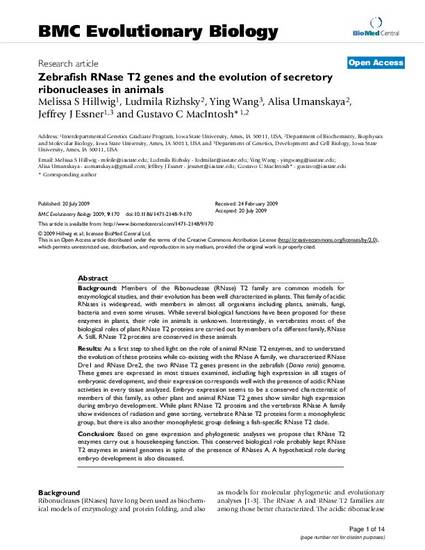
Article
Zebrafish RNase T2 genes and the Evolution of Secretory Ribonucleases in Animals
BMC Evolutionary Biology
Document Type
Article
Disciplines
Publication Version
Published Version
Publication Date
7-1-2009
DOI
10.1186/1471-2148-9-170
Abstract
Background. Members of the Ribonuclease (RNase) T2 family are common models for enzymological studies, and their evolution has been well characterized in plants. This family of acidic RNases is widespread, with members in almost all organisms including plants, animals, fungi, bacteria and even some viruses. While several biological functions have been proposed for these enzymes in plants, their role in animals is unknown. Interestingly, in vertebrates most of the biological roles of plant RNase T2 proteins are carried out by members of a different family, RNase A. Still, RNase T2 proteins are conserved in these animals. Results. As a first step to shed light on the role of animal RNase T2 enzymes, and to understand the evolution of these proteins while co-existing with the RNase A family, we characterized RNase Dre1 and RNase Dre2, the two RNase T2 genes present in the zebrafish (Danio rerio) genome. These genes are expressed in most tissues examined, including high expression in all stages of embryonic development, and their expression corresponds well with the presence of acidic RNase activities in every tissue analyzed. Embryo expression seems to be a conserved characteristic of members of this family, as other plant and animal RNase T2 genes show similar high expression during embryo development. While plant RNase T2 proteins and the vertebrate RNase A family show evidences of radiation and gene sorting, vertebrate RNase T2 proteins form a monophyletic group, but there is also another monophyletic group defining a fish-specific RNase T2 clade. Conclusion. Based on gene expression and phylogenetic analyses we propose that RNase T2 enzymes carry out a housekeeping function. This conserved biological role probably kept RNase T2 enzymes in animal genomes in spite of the presence of RNases A. A hypothetical role during embryo development is also discussed.
Rights
This is an open-access article distributed under the terms of the Creative Commons Attribution License, which permits unrestricted use, distribution, and reproduction in any medium, provided the original author and source are credited.
Copyright Owner
Melissa S. Hillwig, et al
Copyright Date
2009
Language
en
File Format
application/pdf
Citation Information
Melissa Sue Hillwig, Ludmila Rizhsky, Ying Wang, Alisa Umanskaya, et al.. "Zebrafish RNase T2 genes and the Evolution of Secretory Ribonucleases in Animals" BMC Evolutionary Biology Vol. 9 (2009) p. 1 - 14 Available at: http://works.bepress.com/jeffrey_essner/3/

This article is from BMC Evolutionary Biology 9: 170, doi:10.1186/1471-2148-9-170. Posted with permission.